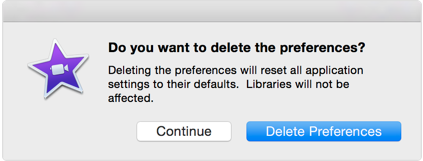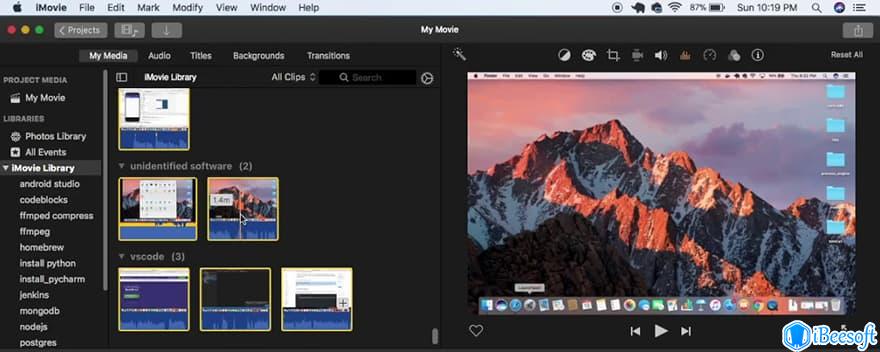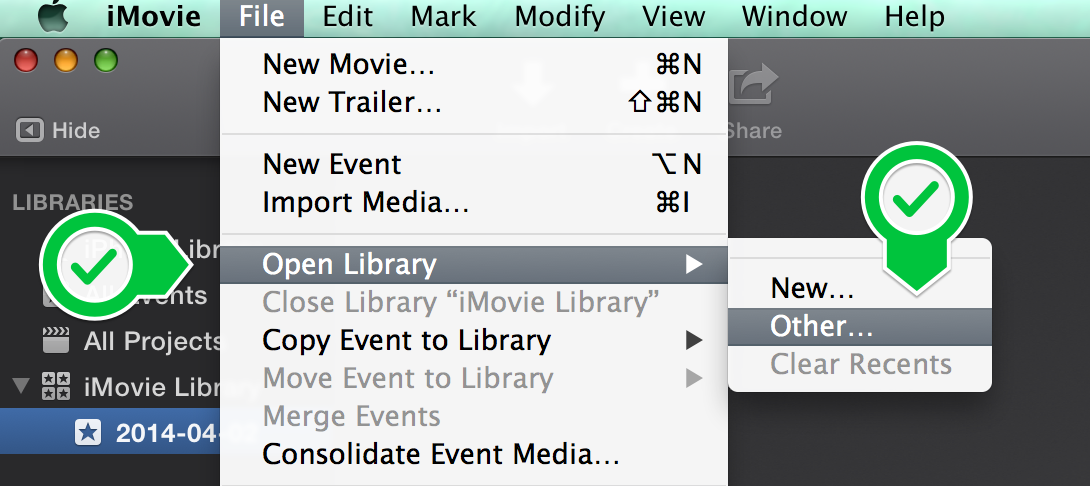Navigate back to Finder and open the Movies folder and move the iMovie Library folder to the external drive. Double click to open it in iMovie to make sure everything is present. Delete the original iMovie Library folder on your internal drive. Clear Disk Space Error – Fix. I’ve just been through a lengthy exercise of moving most of my iMovie events to an external HD to save space on the Mac HD. But they still show up in the iMovie library (by clicking on ‘show package contents’), thus making this library nearly 500GB. These events DON’T show in iMovie when I don’t have the external HD plugged in. Locate iMovie Library under the Movies registry by either double-clicking the Macintosh HD iconon the upper-right corner of the window. Alternatively, click on the Findericon at the foot of the screen. A new Finder window pops up. Open the Movies folder, then drag the file named iMovie Library to your external hard drive. When the library file is finished copying to your external drive, double-click the library file on the external drive to open it in iMovie. If an alert appears asking you to give iMovie access to a removable volume, click OK. How to Find iMovie Files on Mac - Via iMovie Library iMovie acts as your databank to store data or assets such as video, images, and audio. Once you finish editing, close the app by clicking on the red button in the upper left corner of the window.
iPhoto is a part of iLife software application suite, which not only helps you organize and edit your photos, but also lets you get more from these photos by making photo books, greeting cards and slideshows. iPhoto will generates a iPhoto Library folder or package that contains imported photos and any albums you've added using iPhoto.
If you want to move iPhoto Library to a new location or new computer, you must move the entire iPhoto Library folder or package and then identify its new location in iPhoto.
How to Move iPhoto Library to a New Location / Computer
Now you want to move iPhoto Library to a new location in internal drive of Mac computer (frankly, I don't know why, maybe you just want). Other cases include that you run out of hard drive space in Mac (Mountain Lion included) due to the high resolution photos taken by camera, or you just bought a new Mac computer (Mac OS X 10.11 included). Well, see how to move iPhoto Library to a new location or your new computer (using external hard drive). The solution is very similar.
1. Exit iPhoto if open.
2. Open your Pictures folder and select the iPhoto Library.
3a.For a new location: Drag the iPhoto Library folder or package to its new location.
3b.For a new computer: Connect your external hard drive which will display on Finder. Drag the iPhoto Library folder or package to external hard drive.
4. Now open iPhoto (the new computer for moving iPhoto Library to a new computer). Hold down the Option key on the keyboard, and keep the Option key held down until you are prompted to create or choose an iPhoto library.
5. Click Choose Library.
6. Locate and select the iPhoto Library you moved in step 3.
7. Now you will see the photos in the new iPhoto Library or in a new computer's iPhoto Library.
8. Delete the original iPhoto Library if necessary.
9. Moving iPhoto Library complete.
Note: If deleting the old library from the computer's hard drive makes you nervous, you can backup iPhoto to CD/DVD by clicking Share -> Burn before you erase anything.
More about Moving iPhoto Library:
1. The iPhoto library thumbnail is different between pre-iPhoto '08 and post-iPhoto '08. The iPhoto library in iPhoto '08 or later is called a package. See below:

2. You could also move iPhoto library to an external hard drive for backup purpose.
3. Move, delete, rename, or change files or folders in the iPhoto Library folder may make you unable to see your pictures. To slove this problem, you can restore your iPhoto library backup (if exists), or change it back to the original one.
4.There are also applications to help you move iPhoto Library safely, such as iPhotoLibraryManager or iPhotoBuddy.
Unable to access the iPhoto app after installing Catalina? It is because iPhoto has already retired, meaning Apple no longer supports it. In exchange, Apple introduced the Photos app, which does pretty much the same tasks as iPhoto.
Now, we understand if it’s hard for you to let go of the iPhoto app, especially if you have been using it for years. Well, in that case, we have solutions. Below, we’ve enumerated problems and possible solutions related to the use of the iPhoto app. Hopefully, by the end of the post, you’ll have a better understanding of how to overcome your problem and gain access to your media files.
Problem #1: How do you access your media files if iPhoto is no longer here after updating your macOS to Catalina?
Do you have thousands of photos saved in iPhoto? Are all your media files lost? Is there anything you can do? Do you think it is possible to retrieve all your media files when iPhoto no longer works in Catalina?
Many iPhoto app users have these questions, too. So, to make things clear, we can answer by saying that macOS Catalina is keeping you from accessing the app. Macs that run Catalina or later will no longer launch iPhoto because Apple has retired the app.
How To Open Imovie Library Folder
Pro Tip: Scan your Mac for performance issues, junk files, harmful apps, and security threats
that can cause system issues or slow performance.
Special offer. About Outbyte, uninstall instructions, EULA, Privacy Policy.
So, what can you do with this problem? Try any of the solutions below:
1: Simply use the Photos app, which comes pre-installed with macOS Catalina.
Again, iPhoto will no longer work with Catalina. And there seems to be no chance of it working in the future. Thus, your best solution is probably to get all your media files transferred or migrated to the Photos app on your device.
Don’t worry because this new app allows you to quickly import your photos from the iPhoto app. Sp flash tool download for mac. Here’s what you should do:
- Press and hold the Option key.
- Open the Photos app from the Dock.
- A prompt will pop up asking you to choose a specific library that you want to access. From the list, select the iPhoto library.
- Click Choose Library.
- Wait for your photos to be loaded and launched in your new Photos app.
From now on, you can manage all your photos using this app.
2. Recover all your missing photos via the iPhoto app, especially if you have failed to migrate.
In the event that the migration process did not go as planned and you ended up losing all your photos, your best option is to install and use recovery software to recover your lost media files.
There are plenty of file recovery apps you can find online. But we suggest that you use a trusted file recovery tool like Auslogics File Recovery. With this app, you can easily retrieve all the files that you thought were already lost for good. It also works with external storage devices like memory cards and USB drives. It can also be used to recover various file types. With this tool in your arsenal, you won’t have any reason to panic.
Open Imovie Library In Final Cut
Problem #2: I want to upgrade the iPhoto app so it will be compatible with Catalina. Is it possible?
Unfortunately, this is not possible because the iPhoto app is no longer supported on Catalina. iPhoto has long been retired, so no matter what you do, the app will never run on your device. The app uses an outdated framework that Apple no longer supports. Your best option here is to use other apps like Photos.
Aside from the built-in Photos app, which comes with Catalina, here are other app alternatives you can try:
- Picasa – It is photo-editing software developed by Google. It is used for organizing and editing photos and albums.
- Apple Aperture – It is hailed as one of the best apps to replace iPhoto on Apple devices.
- Adobe Photoshop Lightroom – There is a specific version of Adobe Photoshop Lightroom intended for Macs. And it’s more interesting to use compared to other Adobe Photoshop versions.
- Lyn – This app is the perfect companion for Mac users who are also fond of taking photos. It is a must-have for those who have galleries filled with photos from various storage devices.
- Pixa – This app received instant fame because of its way of organizing photos on Macs.
- Google Photos – It is one of the best alternatives to iPhoto as it allows you to manage, upload, and store photos on the cloud. It actually provides you with 15GB of free storage space, which you can use not only for photos but for other files as well.
Gta 5 mac herunterladen. But before you use any of these recommended apps, we suggest that you optimize your Mac first. This way, you can ensure nothing comes your way when editing or organizing your photos.
The best way to optimize your Mac is to use a trusted Mac repair tool like Mac repair app.
In just a few clicks, you can get rid of unnecessary files that may trigger problems and resolve any issues that may arise in the future.

Problem #3: How do you create an iPhoto backup before upgrading to Catalina?
Worried that you might no longer be able to retrieve your media files? You may back up your photos to an external drive before proceeding with the macOS update. Trials in tainted space platinum 190. It’s probably the best way to safekeep your photos.
The good thing is that Mac allows you to easily back up your iPhoto media files. You don’t even need another app to do that. As long as your Mac is in a good running state, then you can proceed with creating a backup in a jiffy.
Here’s what you should do:
- Open Finder.
- Navigate to Users and select Pictures.
- Right-click on the iPhoto Library section.
- Choose the Show Package Contents option.
- Open the Masters folder. You should see all your photos sorted by date or year.
- Copy all the folders and save them onto your external drive.
Congratulations, you have successfully backed up your iPhoto files on your external drive.
The Bottom Line

If you are still hoping to use the iPhoto app after upgrading to Catalina, then you are only wasting your time. There is no way you can use the app after the Catalina update. However, the solutions above should help you get by.
What do you think about the new Photos app? Do you think it makes a great replacement for iPhoto? Let us know in the comments!